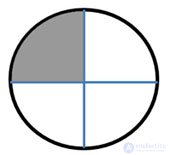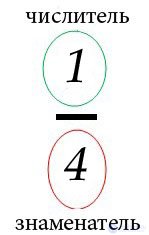Lecture
In life, we often have to use not only whole numbers, but also their parts (fractions).
The shares are equal parts of the whole.
Consider a circle divided into four equal parts.

How many parts of a circle are painted over? One
How many parts is the whole circle divided into? In four parts.
What part of the whole circle is painted over? Answer: 1/4.
The number above the fraction bar is called the numerator . The numerator shows how many shares taken (painted) from the whole.
The number under the fraction bar is called the denominator . The denominator indicates how many equal parts the whole is divided.

To remember that the denominator is the bottom of a fraction , learn a poem:
The banners fell, the denominator is down,
And the numbers fought, the numerator is at the top.
Consider the circle.

This circle is divided into 8 equal shares. Hence, the denominator fraction will be equal to 8.
Three parts are painted in the circle - the numerator will be equal to 3.
In other words, 3/8 of a circle is filled in the circle.
Some ordinary fractions have special names. To know how such fractions are called, it is necessary by heart.
| Fraction | Picture | Fraction name |
|---|---|---|
 |
 |
half |
 |
 |
one third |
 |
 |
one quarter |
Ordinary fractions are closely related to the units of measurement. 1 meter contains 100 cm. That means that 1 m is divided into 100 equal shares. Thus, 1 cm = 1/100 m (one centimeter equals one hundredth of a meter).
Comments
To leave a comment
Arithmetic
Terms: Arithmetic